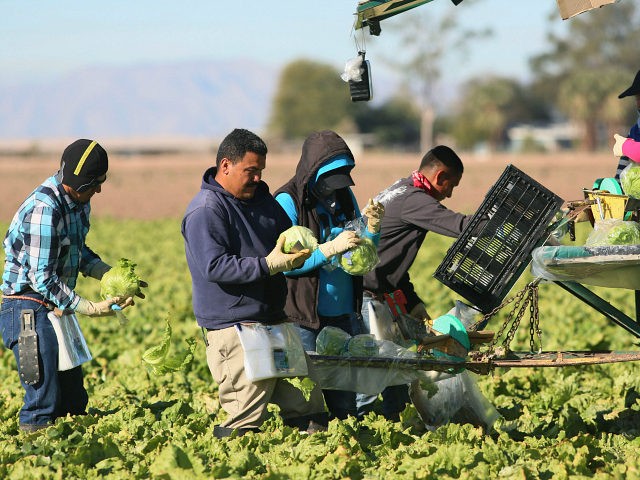The pending farmworker amnesty drafted by Democrats and business groups is likely to block the development and use of labor-saving machinery throughout the labor-intensive farm sector.
The Democratic Party is offering the agriculture business an endless supply of cheap migrant labor if business executives pressure GOP legislators to approve an amnesty for roughly one million illegal migrants who will likely vote Democrat. The profits-for-amnesty swap is at the center of the Farm Workforce Modernization Act of 2019, which has passed a House committee and is expected to get a floor vote soon.
The Democrats’ amnesty bill also has the support of the United Farm Workers union (UFW), which represents illegal migrant farmworkers. The migrants work long hours, in the open, often for low pay.
But they harvest the crops with methods that have changed little in 10,000 years: Stooping to harvest crops, reaching upwards to pick fruit, and carrying simple tools to dig, weed, or prune. The crude methods are good enough for many farm companies that are under intense pressure to minimize near-term spending on payroll and investment in equipment.
Overseas, farm companies in Israel, Australia, Europe, and South America are investing in labor-saving machinery. Their investments in technology are reducing their need for farm workers and are helping them compete against American farmers.
If the Democrats’ “modernization act” amnesty becomes law, U.S. farm companies will have an unlimited supply of low-wage labor and, so, will face less pressure to keep up the pace with their foreign rivals’ technology.
That also means many U.S. farmworkers and their families will be denied the jobs, machines, and tools they need to earn independent and decent lives in rural America, as their GOP-leaning districts turn blue during the next ten years.
The UFW touted its members’ stoop labor in a series of pre-Thanksgiving tweets that were intended to help build support for the agriculture amnesty:
No matter how skilled or diligent, she cannot keep the pace with this Japan-built machine used for harvesting radishes:
Or this Dutch mchine:
The UFW celebrated the use of stoop labor to harvest peas in Salinas, California:
But other countries use machines to harvest peas. In Canada, this farm is using Dutch-built Oxbo machines:
The UFW showcased its members chopping Brussels sprouts with machetes in the United States:
But Europeans use Dutch-built machines to harvest their brussels sprouts: –
In the United States, the UFW touts the manual-labor used to harvest bunches of parsley:
But an Australian-built machine is harvesting bunches of parsley in Europe:
Other farmers use Dutch-built machines to harvest and compress parsley harvests:
In the United States, most farm machinery is built for row crops, such as corn, wheat, soybeans, and potatoes. Congress’ supply of cheap farm labor deters investment by U.S. companies, such as John Deere.
The UFW advertised the harvesting of green tomatoes with stoop labor in Dos Palos, California:
In high-wage Australia, farmers buy machines to increase the productivity of their expensive labor:
Some American farms buy machines to replace the stoop labor. Werner Farms in Indiana, for example:
But farm companies are losing business to so-called “vertical farming,” where tomatoes, lettuce, and herbs are increasingly being grown inside glasshouses, where investors can cut payrolls and costs:
Some harvesting is difficult to automate. Kale leaves, for example, mature at different times, so the UFW’s members pick the leaves one-by-one:
The boxed leaves are then packaged and transported to consumers:
Similarly, no company has developed machines which can harvest green peppers:
Congress’ “farm modernization” act can preserve this widespread use of stoop labor and will slow the mechanization and automation of U.S. food production. But if the bill dies in the senate, farm companies will face continued pressure to raise productivity by automating their stoop labor harvests.
That pressure is already forcing farm companies to hire American engineering to harvest strawberries with new machines:

COMMENTS
Please let us know if you're having issues with commenting.